17 Most Famous Norman Rockwell Paintings in 2025
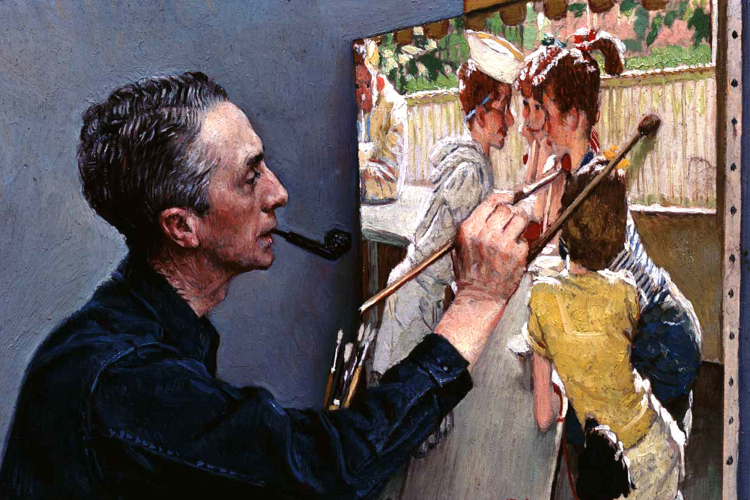
Norman Rockwell paintings are beloved treasures of both American art and history. In this list, we will explore Norman Rockwell's history, his original paintings, as well as Norman Rockwell's art style.
If you’re looking to understand more deeply about this national American treasure and get additional information on the artist, read on to learn about the life, legacy and works of Norman Rockwell, understanding what makes him one of the most famous painters of our time.
Feature image: Self-Portrait of Norman Rockwell Painting the Soda-Jerk (via James Vaughan; CC BY-NC-SA 2.0)
Jump to Section
- Who Was Norman Rockwell?
- What Was Norman Rockwell’s Art Style?
- The Most Famous Norman Rockwell Paintings
Who Was Norman Rockwell?

Norman Percevel Rockwell was born in New York City, United States on February 3, 1894. He showed an early interest, which was nurtured by his parents who appreciated creativity. He would take his pencil and sketch scenes in his notebook, telling imaginative stories. At just 14 years old, he quit high school and enrolled at the Chase Art School, continuing his studies at the National Academy of Design and later, the prestigious Art Students League of New York, where he developed his technical skills under the guidance of renowned artists.
At 18 Rockwell landed his first professional assignment illustrating Carl H. Claudy's children's book Tell Me Why: Stories about Mother Nature. His first major job came when he asked to be the art director for Boys’ Life, the official publication of the Boy Scouts of America. These early experiences helped Rockwell to develop his unique, compelling style defined by his ability to tell visual stories that resonated with everyday Americans.
Rockwell's work at Boys’ Life caught the attention of publishers and art directors. He quickly gained popularity and was thrust into the national spotlight. His illustrations were characterized by meticulous and realistic attention to detail with a warm subject matter. In 1916, at just 22 years old, Rockwell achieved a career milestone when he sold his first cover to The Saturday Evening Post, a publication that became synonymous with his art for nearly five decades. His covers for the Post captured heartwarming and humorous scenes of American life, from small-town moments to patriotic tributes during times of national crisis.
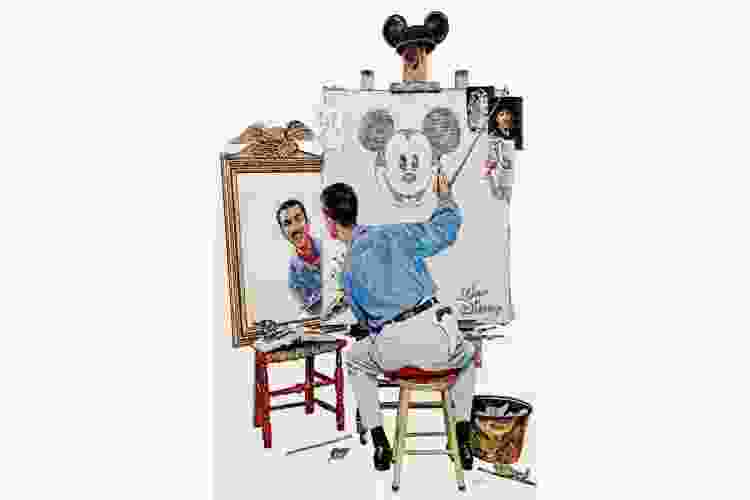
1930 was a major year in Rockwell's life, he divorced Irene O'Connor, became friends with Walt Disney while visiting California, and married his second wife Mary Barstow, a schoolteacher. They would have three sons: Jarvis, Thomas and Peter. In 1939, the Rockwells relocated to Arlington, Vermont, where he focused on everyday small town American scenes, approaching his art with simplicity and humor.
During World War II, Rockwell's "Four Freedoms" series, inspired by Franklin D. Roosevelt’s 1941 speech, became emblematic of American resilience and values. These paintings toured the country, raising millions for war bonds and cementing Rockwell's reputation as a national treasure. They were also reproduced in thousands of posters. After leaving the Post in 1963, he began working for Look magazine, where he tackled more socially conscious themes, including civil rights, the fight against poverty, the Vietnam war and space exploration.
Norman Rockwell’s legacy extended beyond magazine covers; his body of work became a visual archive of 20th-century America. He received numerous accolades, including the Presidential Medal of Freedom in 1977. This is not to say that Norman Rockwell’s paintings are without cultural commentary. While Norman Rockwell paintings were frequently dismissed by critics in his earlier years for being “too soft,” he gained more legitimacy as an artist from the early 1940s to the later 1960s when he began to focus his subject matter on pressing social justice issues.
He utilized his artwork as a platform to depict the political and social climate of America at the time, adding commentary to issues such as racism, sexism and classism. Rockwell published his autobiography in collaboration with his son Thomas called "My Adventures as an Illustrator," in 1960. In 1961 he would marry his third and final wife, Mary Leete Punderson (also Mollie or Molly Punderson). Norman Rockwell passed away in 1978 at his home in Stockbridge, Massachusetts, but his art continues to resonate, offering a timeless reflection of American ideals, struggles, and dreams.
How many paintings did Norman Rockwell paint?

Before Rockwell passed away at the age of 84, he solidified his legacy as a prolific artist, producing over 4,000 original pieces in his lifetime. While many artists use their talents as an exploration of the darker corners of the human experience — look no further than Frida Kahlo and Vincent Van Gogh — Norman Rockwell’s paintings often depict sentimentalized portrayals of the human experience.
What Was Norman Rockwell’s Art Style?
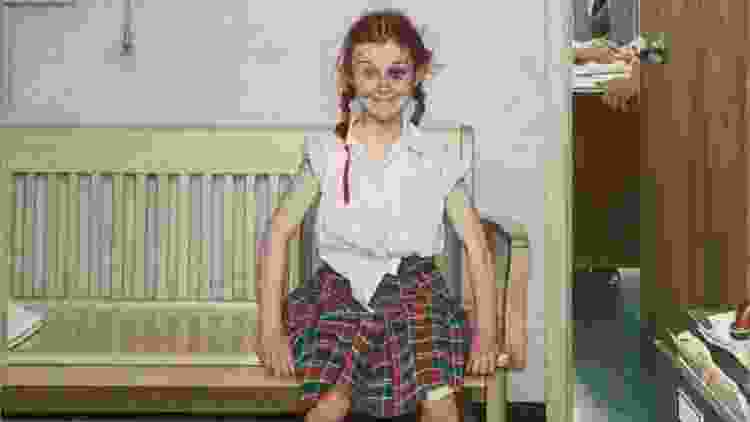
There’s a narrative quality to Norman Rockwell paintings that makes them both relatable and engaging. Rockwell’s paintings could be characterized by the American Realism movement, drawing inspiration from the different generations of Americans, both young and old, who made up the daily grind of the time. His talent for illustration and love for expressive characters gave way to a romanticized view of American life that transcended borders and captured the hearts of the global village.
What are the characteristics of Norman Rockwell's paintings?
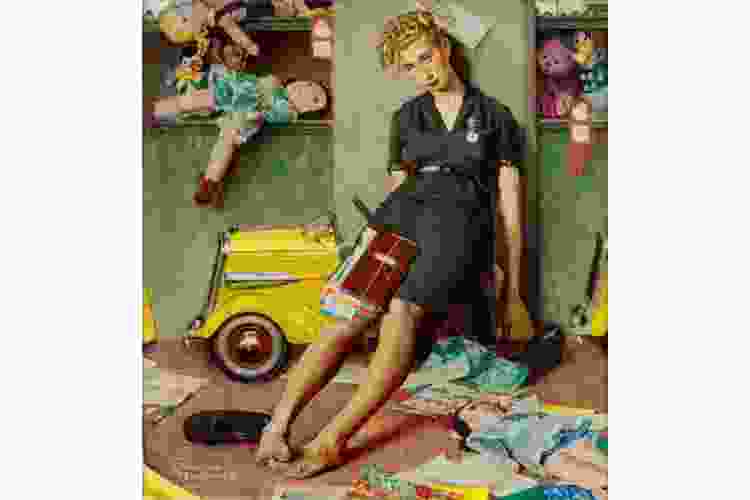
Norman Rockwell paintings are highly realistic. You can almost feel the veiny knuckles of an old man’s hand or the soft white and brown fur of a beloved pet. Norman Rockwell paintings have a clear focus, allowing viewers to easily understand his depictions thanks to a lack of visual distractions. Utilizing a warm and inviting color palette, Rockwell incorporated a sense of whimsy in many of his paintings. Depending on the decade, Rockwell's paintings usually have a patriotic, humorous, nostalgic or politically-geared subject matter. "Tired Salesgirl on Christmas Eve" for example is a social commentary on consumerism during what is meant to be a time of giving, family and love.
How long did it take Norman Rockwell to finish a painting?
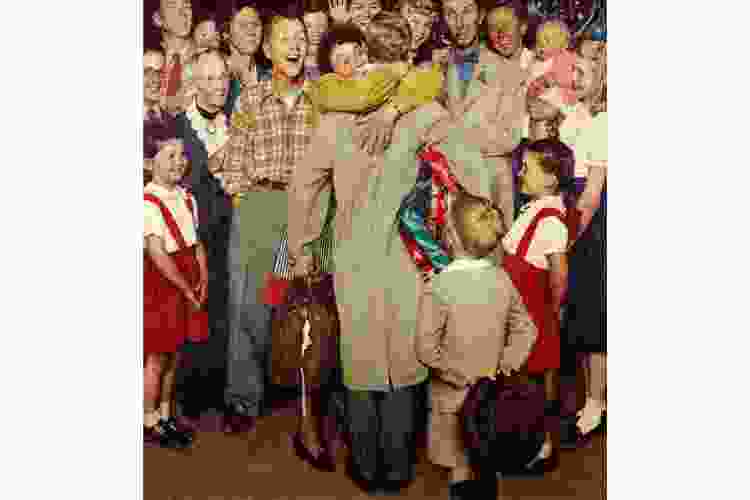
According to an article shared by the Brooklyn Museum, Norman Rockwell: Behind the Camera, while the artist was a natural storyteller, “he found it difficult to paint purely from imagination.” And so, by the mid-1930s, photography became an important element to his creative process, which in turn, lengthened it as well. From conceptualizing and planning to drawing and revisions, it took Rockwell approximately six to eight weeks to finish a piece.
What is the most valuable Norman Rockwell painting?
What is the most valuable Norman Rockwell painting? Well, it’s hard to pin down the true value of Norman Rockwell’s paintings, but if we were to measure their worth by price, Saving Grace (1951) (number 17 in our list) takes the cake. According to a report by NPR, this Norman Rockwell painting sold at an auction for $46 million dollars in 2013. At the time, that was the highest price a painting had sold at auction. It's not quite in the hundreds of millions that the most expensive paintings sell for, but it's pretty high for someone who was considered an illustrator over purely an artist.
Where is the Norman Rockwell Museum?

If you're wondering, "Where can I see Norman Rockwell Paintings?" you will find the largest collection of Norman Rockwell paintings at the Norman Rockwell Museum in Stockbridge, Massachusetts. Included in this iconic collection are many of the covers he produced for The Saturday Evening Post. Not only can you explore a plethora of Norman Rockwell paintings, but you can also attend educational programs and events that celebrate Rockwell’s mighty career. You can even visit the gift shop to bring home some Norman Rockwell prints.
The Most Famous Norman Rockwell Paintings
1. The Peace Corps (JFK's Bold Legacy) (1966)

In 1961, President John F. Kennedy assembled the Peace Corps, a program with the mission to promote international friendship and world peace. Rockwell’s 1966 painting captures the altruistic nature of the Peace Corps. It features a profile of President John F. Kennedy leading a diverse group of individuals, symbolizing the inclusive spirit of the Peace Corps. The figures represent volunteers from various ethnic backgrounds, highlighting the organization's commitment to serving communities worldwide. While the painting includes a portrait of President Kennedy, the other individuals are symbolic representations rather than specific, identifiable people.
This is still one of the most powerful Norman Rockwell paintings, as it stands as a reminder of America’s strength and capacity for change that comes from a collective effort versus the limitations and challenges that follow an individual pursuit alone.
2. The Problem We All Live With (1963)

This is yet another one of the most powerful Norman Rockwell paintings as it depicts Ruby Bridges who, at only six years old, was the first black child to attend a formerly all-white school when activists began the work of dismantling segregation.
Ruby Bridges is depicted in an all-white dress carrying a notebook in one hand as she is escorted by 3 Marshalls. You cannot see the faces of the Marshalls as they are cut off at the shoulders, calling attention to Bridges and her innocence. She is calm and almost determined, a sharp contrast from the hostility she faced at a time when integration was still a topic of debate. You can note the signs of hatred and racism from the atrocious graffiti sprawled on the wall to the smashed tomato. Ruby remains calm amid the turmoil.
3. New Kids in the Neighborhood (1967)

New Kids in the Neighborhood is one of the Norman Rockwell paintings that captured the attention of many. It addresses the reality of integration outside of the school system. Two black children, a boy and a girl, make up our central figures who just moved to a new suburban all-White neighborhood. Across from them, three white children lean curiously toward their new neighbors. Even their dog looks scared and curious of the newcomers.
While there is a tense essence in the painting that reflects the attitude of the time, there is also a sense of hopefulness in the depiction of children, conveying an impending, important and long-overdue change.
4. Murder in Mississippi (Southern Justice) (1965)
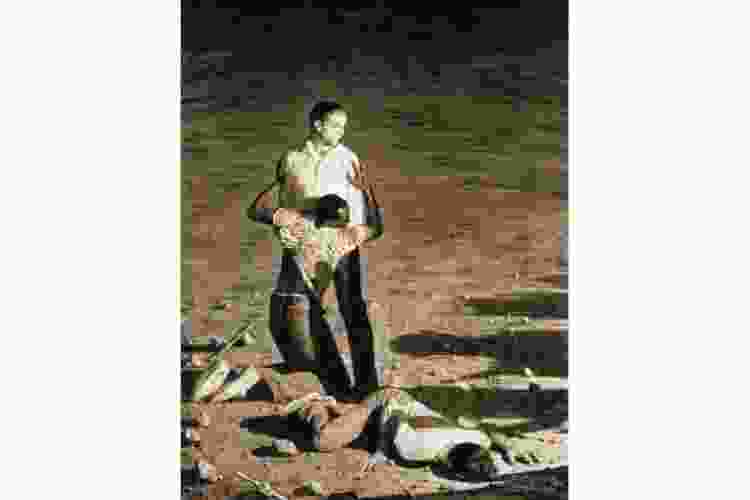
During the Freedom Summer of 1964, three civil rights workers were tragically murdered: James Chaney, Andrew Goodman and Michael Schwerner. This horrific event took place in Neshoba County, Mississippi, hence the name Murder in Mississippi.
This is one of the Norman Rockwell paintings that depicts the aftermath of the violent end of these three civil rights workers. The figures are seen in various forms of dying, surrounded by a dark and gray color palette, emphasizing a grim scene of morality, violence and destruction — while the ominous shadows of the murderers loom on the ground.
5. The Right to Know (1968)
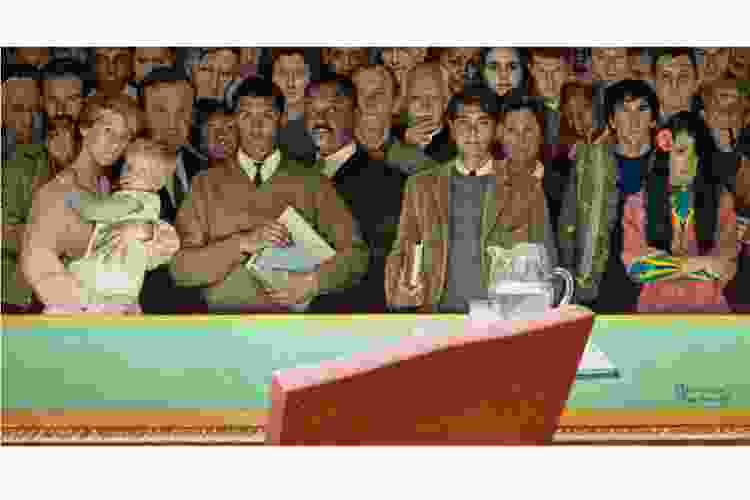
The Right to Know is one of the most famous Norman Rockwell paintings, created for an editorial in Look Magazine. The editorial was written at a time of growing opposition to the war in Vietnam. It advocated for government transparency, which was only emphasized by Rockwell’s accompanying painting. A group of figures ranging in age, the youngest being a child, are depicted from a judge’s perspective in a courtroom. The figures stare directly ahead, meeting the eye of the beholder. Peer over to the far right and you'll see Rockwell himself staring back at you, pipe in mouth.
Like most Norman Rockwell paintings, this was produced using oil on canvas, one of the most popular paint mediums both then and now. If you're on a quest to understand oil painting for beginners, Norman Rockwell paintings provide a masterclass on the medium, ending the debate on acrylic versus oil paint.
6. War News (1943-44)
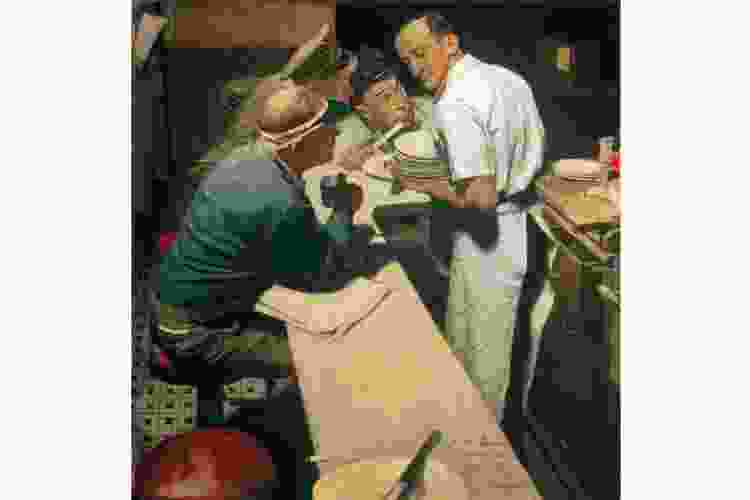
Norman Rockwell created an astounding 323 covers for the Saturday Evening Post. For over 50 years, audiences admired his portrayal of American life and culture. Many ask, what is the most famous Norman Rockwell painting? Although this is hard to measure, War News is at the top of the list even though it never actually reached the cover.
War News is one of the Norman Rockwell paintings that captures the emotional investment citizens displayed throughout World War II. Four characters, a Western Union boy, a clerk, a deliveryman and a server gather around a radio in a diner to listen to a report. Nobody knows why Rockwell decided against submitting War News as the cover of the Saturday Evening Post, but some say it is too difficult to tell what the characters are listening to on the radio.
7. Hey Fellers, Come On In! (1920)

This is one of the lighter Norman Rockwell paintings, as it is a celebration of boyhood. Two boys are swimming carelessly in a body of water. One bobs his head above water in the background while the other steals the viewer’s attention, waving as if to invite you to jump in for a swim. This was painted in 1920, just two years after the end of the First World War.
8. Christmas Trio (1923)
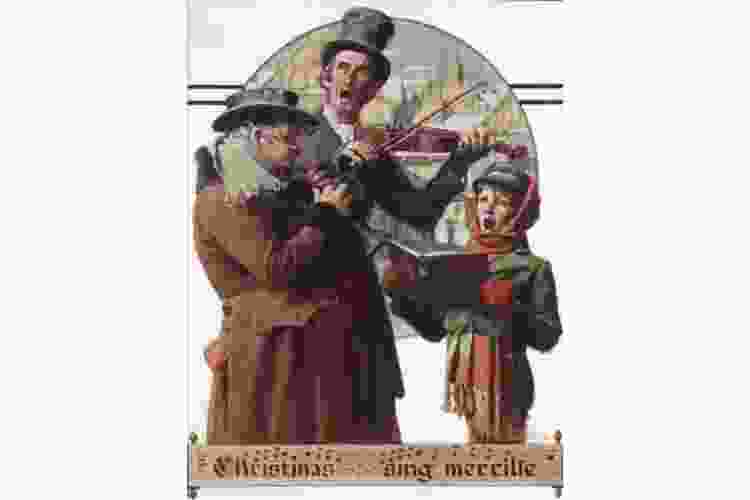
Christmas trio is a traditional holiday scene that brings with it a nostalgic sense of joy and wonder. Three figures, two men and one child, are bundled up in winter clothing, performing a Christmas carol. The trio is centered on the canvas with fine details outlining their expressions and movements, while the background remains still, almost lightly sketched. Like a few other Norman Rockwell paintings, Christmas Trio was produced shortly after WWII, during a time of economic resurgence. In other words, spirits were high.
9. Freedom from Want (1943)
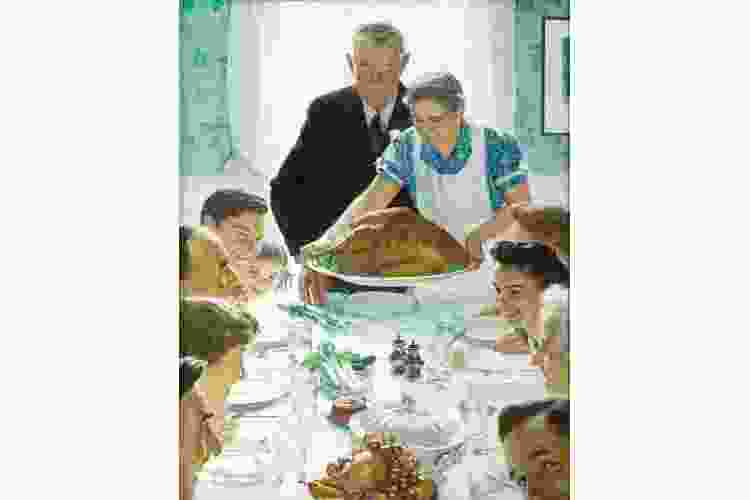
Freedom from Want is one of the most famous Norman Rockwell original paintings. This Norman Rockwell original painting depicts a family gathering around the dinner table for a Thanksgiving feast. Rockwell used a vertical format to present the characters in a manner that draws the viewer's attention toward the turkey at the top of the canvas.
Similar to other popular Norman Rockwell paintings, the realistic style gives the art breath, highlighting the values of the nuclear, American family. Freedom from Want is the first in Rockwell’s Four Freedoms series.
10. Freedom of Speech (1943)
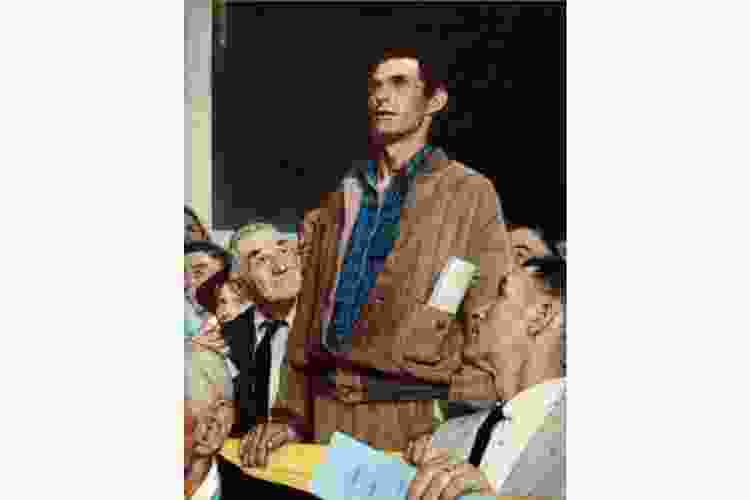
The next installment of the Four Freedom series, Freedom of Speech, shows a blue-collar man in simple clothes, standing up to speak at a town hall meeting. Although a part of the working class, the man stands tall and confident even though he is surrounded by men of higher class. This is another one of the Norman Rockwell paintings with a deeper meaning. Here, Rockwell emphasized the importance of civic engagement, reminding us that community plays a vital role in maintaining our freedom.
11. Freedom of Worship (1943)

The third edition to Rockwell’s Four Freedom series, Freedom of Worship, illustrates a group of individuals each occupied in prayer or worship. They are each shown worshiping in their own way, based on their own private religious belief. We only see the characters' faces and hands, portrayed in acute detail. This is one of the most impactful Norman Rockwell paintings, considering the fact that many people faced intense religious persecution in the 1940s when freedom to worship was created.
12. Freedom from Fear (1943)
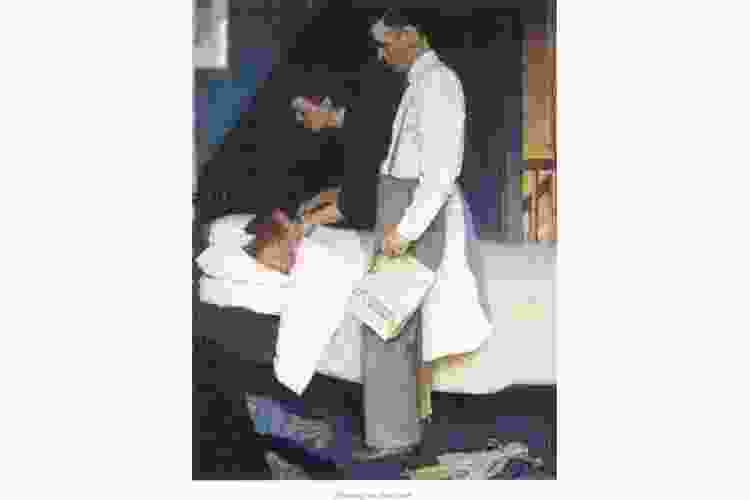
Freedom from Fear is the last of Rockwell’s Four Freedom series. It is one of the most sweet and gentle Norman Rockwell paintings, but there is a dark undertone. Parents tuck their two children to bed who both seem to have already fallen asleep. The mother lifts a blanket over her children’s shoulders while their father watches tenderly, holding a newspaper with a headline that includes the words "bombings" and "horror." While the scene itself feels nostalgic and soft, this is a strong juxtaposition of the fear that gripped the world during World War II.
13. Rosie the Riveter (1943)
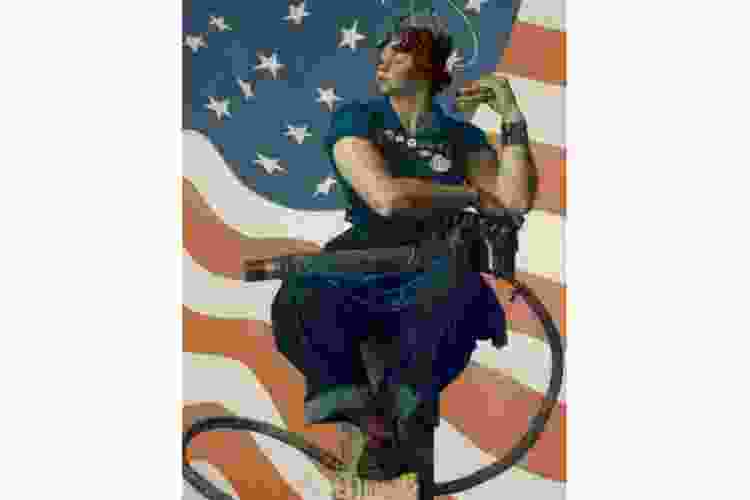
We all know of Rosie the Riveter as a strong symbol of the roles women took on during World War II, especially the notorious image "We Can Do It!" by J. Howard Miller. This is one of the Norman Rockwell paintings that added another powerful element to the portrayal of Rosie. In this Rockwell scene, she is positioned in a powerful stance as if she were a monument with her foot stomping on a copy of adult Hitler's infamous and corrupt book. This was a powerful reminder of the role women played in contributing to the end of World War II.
14. Growth of a Leader (1964)
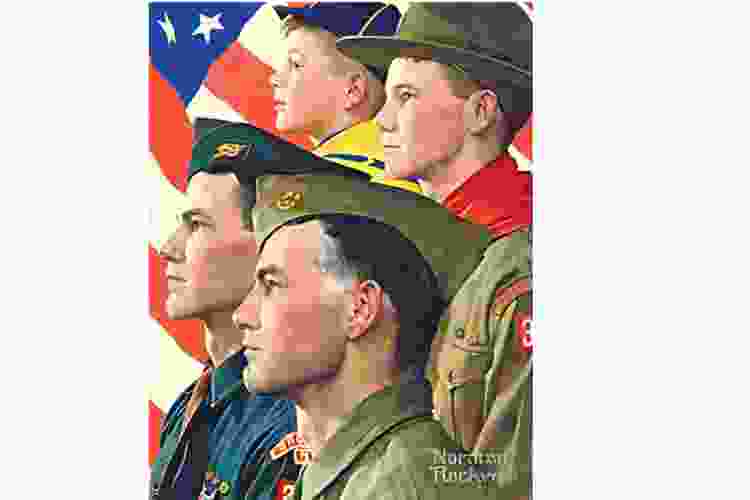
As mentioned earlier, Rockwell used photography as a way to establish a scene for his paintings. A man named James Edgerton was one of Rockwell’s longtime models. In Growth of a Leader, Edgerton and his son are depicted in a way that portrays the stages of a man’s career from Boy Scout to leader. Or, in another sense, from boy to man. Separate from the other Norman Rockwell paintings that appeared on magazine covers, this Norman Rockwell painting appeared in the 1966 Brown & Bigelow Boy Scout calendar.
15. Triple Self-Portrait (1960)

Triple Self-Portrait is one of the more curious Norman Rockwell paintings, and one of his most interesting self portrait ideas. He portrays himself using his favorite painting technique, oil on canvas. The viewer watches Rockwell paint a painting of him painting himself — what a concept! The trippy painting idea and use of composition, with its inherent introspection, makes it one of the most abstract painting ideas in the canon of Norman Rockwell paintings — a far cry from the typical moments he normally captured.
16. Breaking Home Ties (1954)
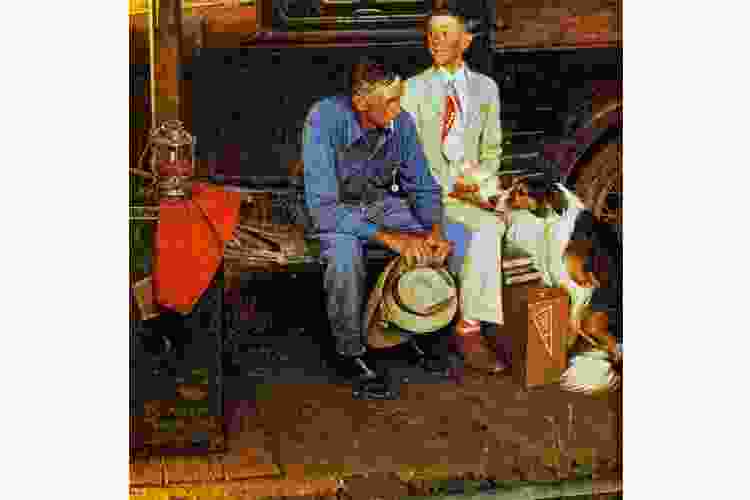
A son sits beside his father on the side of an old car in Breaking Home Ties, neither character looking the other in the eye. The young man wears a crisp white suit and keeps a briefcase by his foot, ready to begin a new adventure. The father hunches over in his work clothes, holding a hat in his hand. This is one of the most significant Norman Rockwell paintings as it reflects two very different men who feel the tense differences between the ideals of their respective generations.
17. Saying Grace (1951)
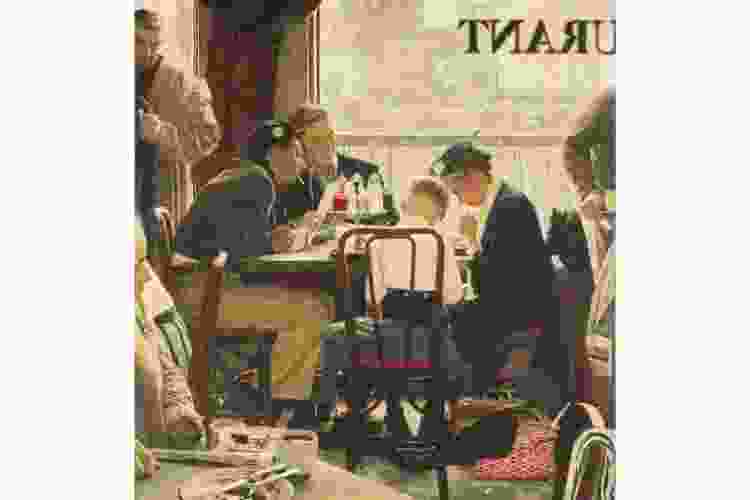
In Saying Grace by Norman Rockwell, a grandmother and her grandson pray in a crowded diner. Onlookers stare at them as they bow their heads. The expressions of the onlookers are both curious and respectful, as they admire this quiet moment of prayer from afar. As previously mentioned, this is one of the most expensive Norman Rockwell paintings ever sold. While the original has already been auctioned, for much less than 46 million, you can get your own Saving Grace thanks to all the Norman Rockwell prints out there.
All painters can learn a lesson from Norman Rockwell’s paintings. Whether it’s a lesson in how to start oil painting or a lesson in understanding the cultural significance of community work, studying Norman Rockwell’s paintings will help you grow as both an artist and as a person.
For even more fun painting ideas, check out other experiences happening on Classpop!

